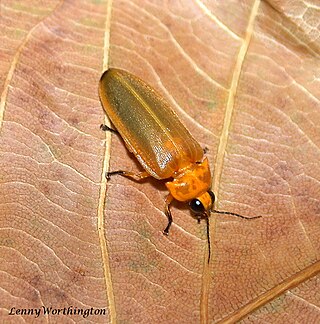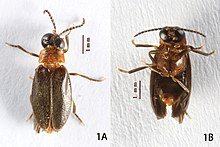Semia is a genus of Asian cicadas in the tribe Cicadini, erected by Matsumura in 1917.

Attacus atlas, the Atlas moth, is a large saturniid moth endemic to the forests of Asia. The species was described by Carl Linnaeus in his 1758 10th edition of Systema Naturae.

Mai Po Marshes (Chinese: 米埔濕地; Hong Kong Hakka: Mi3bu4 Sip5ti4) is a nature reserve located in San Tin near Yuen Long in Hong Kong. it is within Yuen Long District.

Physignathus cocincinus is a species of agamid lizard native to southern China and mainland Southeast Asia. It is commonly known as the Chinese water dragon, Indochinese water dragon, Asian water dragon, Thai water dragon, or green water dragon.

Pygidicranidae is a family of earwigs in the suborder Neodermaptera. The family currently contains twelve subfamilies and twenty six genera. Eight of the subfamilies are monotypic, each containing a single genus. Of the subfamilies, both Astreptolabidinae and Burmapygiinae are extinct and known solely from fossils found in Burmese amber. Similarly Archaeosoma, Gallinympha, and Geosoma, which have not been placed into any of the subfamilies, are also known only from fossils. Living members of the family are found in Australia, South Africa, North America, and Asia. The monotypic genus Anataelia, described by Ignacio Bolivar in 1899, is found only on the Canary Islands. As with all members of Neodermaptera, pygidicranids do not have any ocelli. The typical pygidicranid bodyplan includes a small, flattened-looking body, which has a dense covering of bristly hairs (setae). The pair of cerci at the end of the abdomen are symmetrical in structure. The head is broad, with the fourth, fifth and sixth antenna segments (antennomeres) that are not transverse. In general Pygidicranids also have equally sized ventral cervical sclerites, and in having the rearmost sclerite separated from, or only touching the center of the prosternum. Cannibalism of young has been observed in at least one species in the family, Challia hongkongensis, in which an adult female was found eating a still-living nymph of the same species. The same species in a different area has been observed possibly eating fruits or seeds, making the species an omnivore.

Actias ningpoana, the Chinese moon moth, is a moth of the family Saturniidae. The species was first described by father-and-son entomologists Cajetan and Rudolf Felder in 1862. It is quite large, and has long, curved, hindwing tails. There are many congeners across Asia; the Luna moth of Eastern Canada and the United States is a close relative.
Amolops daorum is a species of frog in the family Ranidae. It is known from its type locality in the vicinity of Sa Pa in northern Vietnam near the Chinese border, Hong Kong, and Houaphanh Province in eastern Laos; presumably it also occurs the intervening areas. The Hong Kong record is considered suspicious, however.

Astreptolabis is an extinct genus of earwig in the Dermaptera family Pygidicranidae known from a group of Cretaceous fossils found in Myanmar. The genus contains two described species, Astreptolabis ethirosomatia and Astreptolabis laevis and is the sole member of the subfamily Astreptolabidinae.
China Liv Pro Cycling is a professional women's road bicycle racing team initially based Hong Kong until 2021 and then based out of China.
Aquatica ficta is a species of firefly found in Taiwan and parts of China. It was formerly placed in the genus Luciola. Its habitat is still water, and the larvae are aquatic.
Aquatica hydrophila is a species of firefly found in Taiwan. Described in 2003, it was formerly placed in the genus Luciola. The larvae are aquatic and live in ditches and small streams.

Aquatica lateralis, known as "heike-botaru" (ヘイケボタル) in Japanese, is a species of firefly found in Russia, Japan and Korea. It was formerly placed in the genus Luciola. The larvae are aquatic and live in rice paddies.
Oculogryphus fulvus, is a species of firefly beetles belonging to the family Lampyridae. It is endemic to Vietnam.

Oculogryphus chenghoiyanae, is a species of firefly beetles belonging to the family Lampyridae. It is endemic to Hong Kong.
Oculogryphus bicolor, is a species of firefly beetles belonging to the family Lampyridae. It is endemic to Vietnam.
Oculogryphus shuensis, is a species of firefly beetles belonging to the family Lampyridae. It is endemic to China.
Andixius longispinus, is a species of planthoppers belonging to the family Cixiidae. It is endemic to China.

Andixius trifurcus, is a species of planthoppers belonging to the family Cixiidae. It is endemic to Yunnan, China.
Abscondita chinensis, is a species of firefly beetle found in India, China and Sri Lanka.

Pteroptyx is a genus of fireflies in the subfamily Luciolinae found in Southeast Asia. It has long been noted for the ability to perform synchronous flashing, though not all species synchronize. These synchronizing species have been found on so-called 'firefly trees' and created a growing firefly-watching tour industry in some regions. Species of the genus have been identified in Malaysia, Thailand, the Philippines, and Hong Kong.










